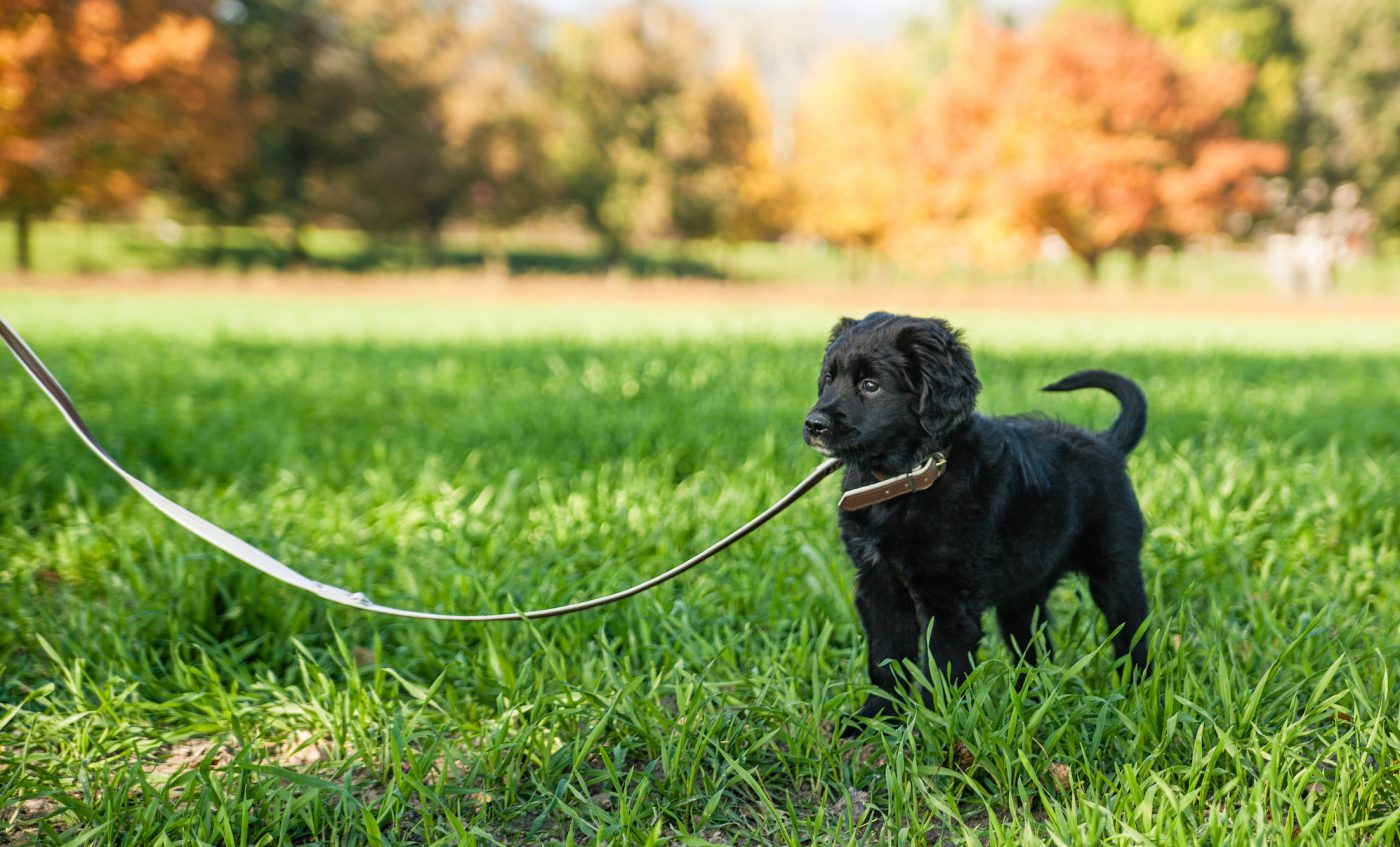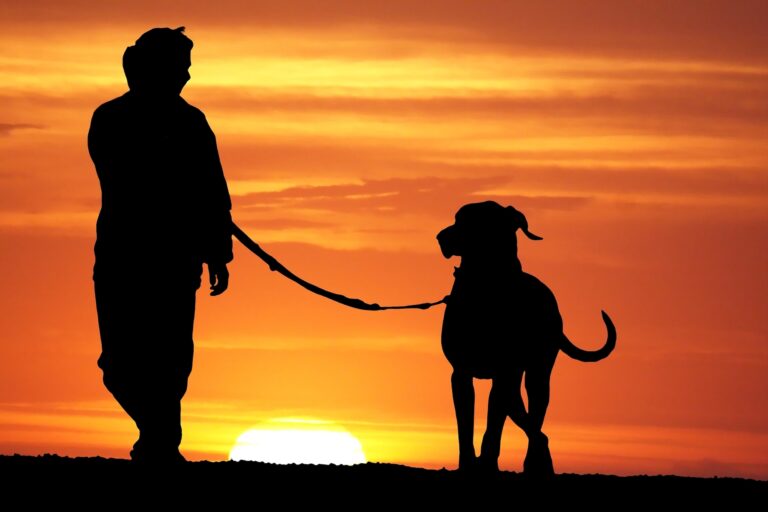For a puppy, being connected to us via a leash and going where we go, when we want to go, doesn’t come naturally; it has to be taught. And leash skills are among the most important things you’ll teach—walking together is a big part of a healthy, happy relationship with a dog.
We’ve all seen (and perhaps been) the people getting dragged down the street by their canine companion. That’s not an enjoyable way to walk, and, if it happens regularly, it can set up an unhealthy dynamic for your relationship, on the street or at home.
The most important aspect of teaching your puppy to walk on a leash is to build engagement with you. You want your dog to think being near you is safer, and more fun, than anything else so they will choose to stay close while walking on leash.
Here are some of the steps you can take with your puppy toward a lifetime of happy walking together.
Leash training: supplies needed
- Flat buckle collar and/or a harness
- Six-foot leash
- Treats that your dog is very excited about (and a treat pouch)
- Patience
For puppies under four or five months old, it’s preferable to start with a well-fitted harness with a back attachment point that doesn’t restrict their natural gait.
When your puppy is a bit older and you’re ready to start more “formal” training, with your dog heeling while walking out on the street, you may consider switching to a collar or head halter. This way, your pup hasn’t already learned to pull on a collar, which makes training loose-leash walking or heeling a lot easier.
You’ll also need a simple 6-foot leather, biothane, or nylon leash that is comfortable to hold in your hand. Avoid retractable leashes. They can lead to rope-burn injuries in people and generally teach your dog to pull and focus away from you—which is the opposite of what you want when teaching them to walk on leash.
When to start leash training your puppy
You can start teaching leash lessons as soon as you bring your puppy home. Ideally puppies will remain with their mothers for the first eight to 12 weeks, so you’d likely be starting around this time, but you can introduce basic principles earlier. Don’t wait—this formative period can be the best time to socialize and teach good habits.
Do keep in mind that puppies under four to five months old won’t have complete focus or self-control (both of which are required for loose-leash walking), so for younger puppies, start slow and in controlled areas, getting them used to the collar and leash, and introducing the concept of following you around.
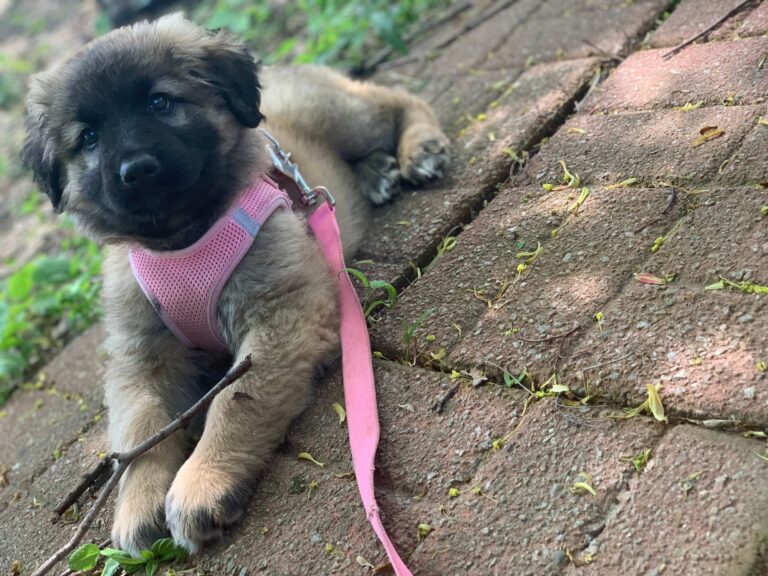
When you’re ready to walk…
Introduce the harness to your puppy: Show your puppy the harness inside the house away from distractions and allow them to sniff while praising and offering treats. You want to make sure that your puppy makes positive associations with this gear, instead of seeing it as something to scratch at or resist.
Put the harness on your puppy: First, put the harness on briefly while offering treats and praise, and then immediately remove the harness.
After a few repetitions, if your puppy is comfortable wearing the harness, start to slowly increase the amount of time that they have it on. A great way to do this is to put the harness on your puppy and then engage in play with toys, or toss treats for your pup to chase.
Tip: Get in the habit of putting the harness on just before meal time and training time (which includes treats) so your dog begins to associate it with good things and look forward to it.
Introduce the leash: At first, after attaching the leash, let your puppy walk around dragging it (supervising to avoid any mishaps). Again, you can distract them with toys so the leash doesn’t become the focus of attention. Like the collar, you want to associate the leash with good things, instead of having your puppy immediately start pulling or biting it when it’s clipped on.
Start walking with small steps
Once your dog is comfortable wearing their harness and leash, you’re ready to start working on walking together.
Start indoors, in an area with limited distractions, like your living room or a hallway. You want to help your puppy understand that being near you and walking with you will be highly rewarded instead of allowing them to get too frustrated by repeatedly reaching the end of the leash.
Attach the leash, show your pup you have treats, and give them treats for being near you. Next take small steps away from your puppy—when they come to you, reward them with a treat. It can be helpful to introduce a marker word or sound—the instant that your puppy turns toward you, mark with the word, and reward with a treat.
The big goal at this stage is teaching your dog that staying near you while walking is a great choice! As you move, add a mild amount of tension on the leash towards you, using body language suggesting that you have something good for them if they come your way. If you are using markers (which is recommended) you should release tension on leash and mark as the dog approaches you for the reward (moving towards you makes the tension on the leash go away and also gets a marker that yields a reward). Be sure to have your puppy come to you for the reward instead of going to them.
Repeat the process of step, treat/praise in this area of limited distractions until your puppy walks with you a few steps. Make sure your puppy isn’t jumping up to get the treat—give the treat down at their height.
As your pup gets used to walking near you, lower the treat to their nose and walk forward a few steps. As they follow beside you, mark with a word and reward them with the treat. If they start to pull or amble around, reset them into position beside you and start again.
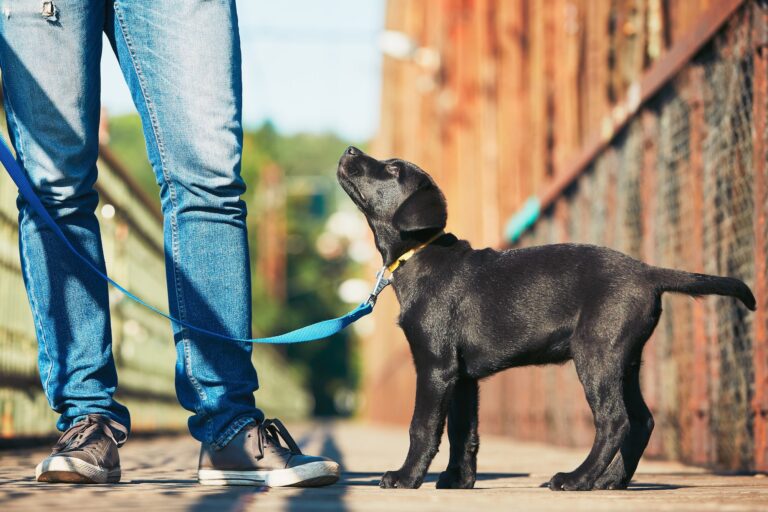
Practice walking in different environments
After practicing indoors and getting to a point where your puppy is reliably following you on the leash, walk in new, and more distracting, areas. This “proofing” principle applies to many kinds of training—if you teach your dog a behavior in one controlled environment, it doesn’t mean they’ll reliably perform that behavior in other environments. Move to a place that’s still controlled, but has more distractions—like the backyard—and practice until they are reliable in this setting.
Tip: If your puppy is going potty in the backyard, use trips for potty breaks to practice walking skills (this is a double win, allowing you to work in more leash practice and training your dog to go potty in a certain spot instead of just anywhere).
Try to keep the level of engagement up as you start to increase the distractions they are exposed to. The key is to make yourself, and walking alongside you, more interesting than the distractions.
Don’t “level up” too fast; that is, don’t go from the backyard directly to a busy street at rush hour. Try to slowly build up the level of distraction by first starting to walk on a quiet street, maybe early in the morning, then progressing to busier areas and times. Some dog owners find it helpful to use an “intermediate” place that’s outside—like a courtyard or parking lot—before jumping to a busy sidewalk.
Give praise and treats anytime your dog is next to you or offers you a look to check in with you. As they get better at walking with you, reduce the frequency of treating. Try changing speeds and directions and having your puppy stay at your side.
Some puppies will take to the leash with little resistance; for others it may take more time. Remember that young puppies have limited focus. Don’t push them too far, too fast—try to stick within the window during which they’ll happily walk around without fighting the leash.
Pick a side!
Depending on what’s going on around you, it might be easier or safer to have your dog on one side or another, but, in general, you don’t want your dog to be crossing back and forth from the left to right while on a walk. The left side is traditionally recommended (and that’s the side to use if you plan to eventually compete in dog sports), but either side will do as long as you stick to it. You can teach your dog to stay on one side by always treating your dog on the side that you want them for that walk. This means your dog will quickly begin to automatically go to that side looking for the treat/reward. If your dog goes to the other side or starts pulling towards something, just get their attention with a treat—lure them back to the side you want them to walk on, then praise and feed the treat.
Troubleshooting
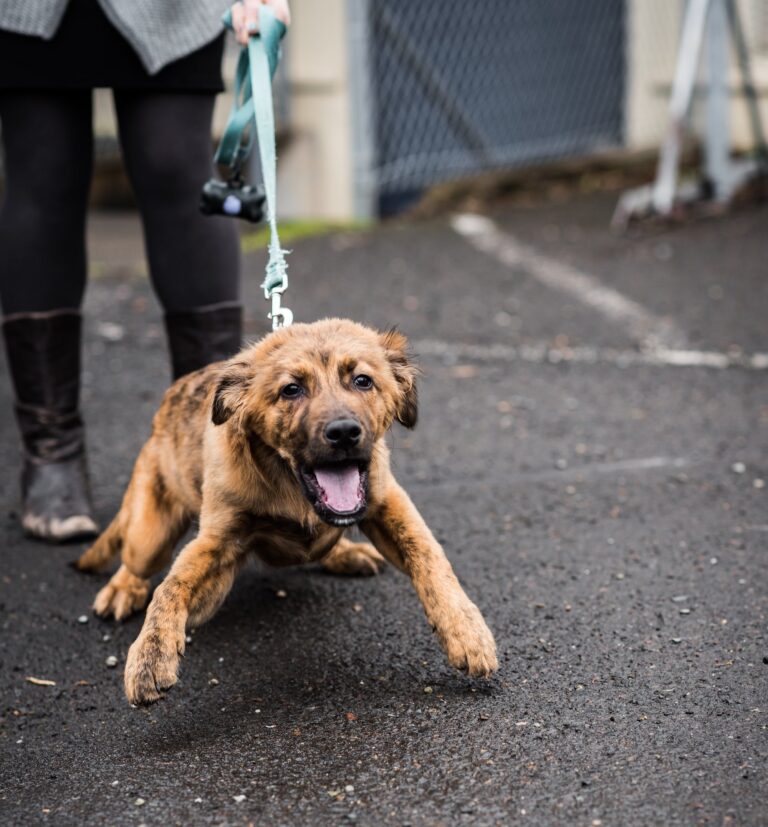
Managing pulling behavior
It’s natural for puppies to want to explore their world, which means they’ll probably pull at the end of the leash to try to get something or somewhere. It’s important to not inadvertently reward this behavior by pulling back, or by allowing them to pull their way to where they want to be. Remember that simply continuing to walk is a reward for pulling.
The first step to discourage pulling is to not move forward. When they pull, stop walking until you get slack on the leash, then resume walking. At this stage anything that reinforces the desired action—your dog moving toward you—will help. So, if you’ve been practicing applying mild leash tension as you encourage the dog to come your way (see the “small steps” section), you can use a little tension here as a way of offering more guidance as to what’s expected.
This part can require patience, as your “walk” may not be continuous forward motion.
Tip: Don’t ONLY offer treats after your dog has stopped pulling. Reward them when they haven’t been pulling and are simply near you. If the treat only comes out when the dog has been pulling and then stops, they might see pulling as the thing that initiates the “game.”
Reactivity
If you see something that is going to be extra challenging for your puppy—like a child playing with a ball, squirrels, or other dogs—give them extra help keeping the focus on you.
First, find ways to keep a distance from things that you know are really hard for your puppy to resist. This will keep them below threshold, meaning they can still focus and take treats. Once your dog is reacting (barking/lunging/etc), they are over threshold and can’t think or learn. To keep distance you may need to cross the street if you see another dog, or pick walking routes that allow you to avoid or keep distance from, say, a basketball court.
When you can, try to get within view of the offending dog or object, but not close enough to trigger a negative reaction, and offer small bits of high value treats to your puppy. The goal is to both keep your puppy’s attention and help them begin to start making positive associations with the thing they are fearful or over-aroused about.
When you’re passing close to triggers, you can also take treats in your hand, bring them right down to your dog’s nose, keep them there until the distraction has passed—and then feed them. By luring your dog through a very distracting situation and keeping their attention on you, you’ll reinforce that paying attention to you is going to be rewarded and help create new associations with whatever they are reactive to.
Be patient
It can be tempting to think of going for a walk as a simple act and end up inadvertently pushing your dog too hard too fast. It’s always OK to decrease the intensity of a walk by finding less-busy places to practice. Going slow and keeping your walks fun is what will help your dog build positive associations with things that may otherwise overwhelm them.
If walking is stressful or overwhelming, or even if it isn’t, don’t hesitate to seek support from a trusted dog trainer. Many dog owners who struggle with leash training find they get to a breakthrough with the help of a trainer, who can help create a personalized plan to help you and your dog learn to enjoy a lifetime of walking together.



